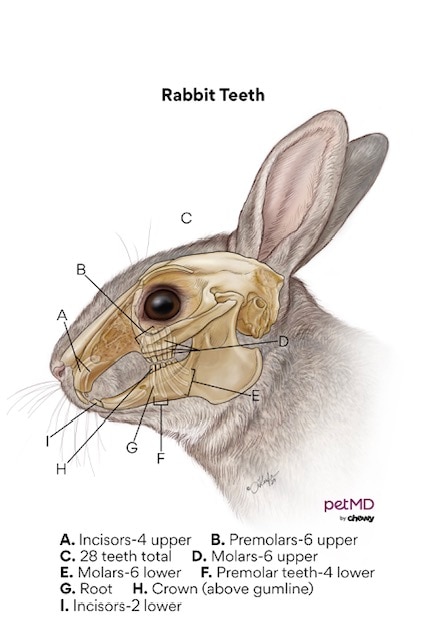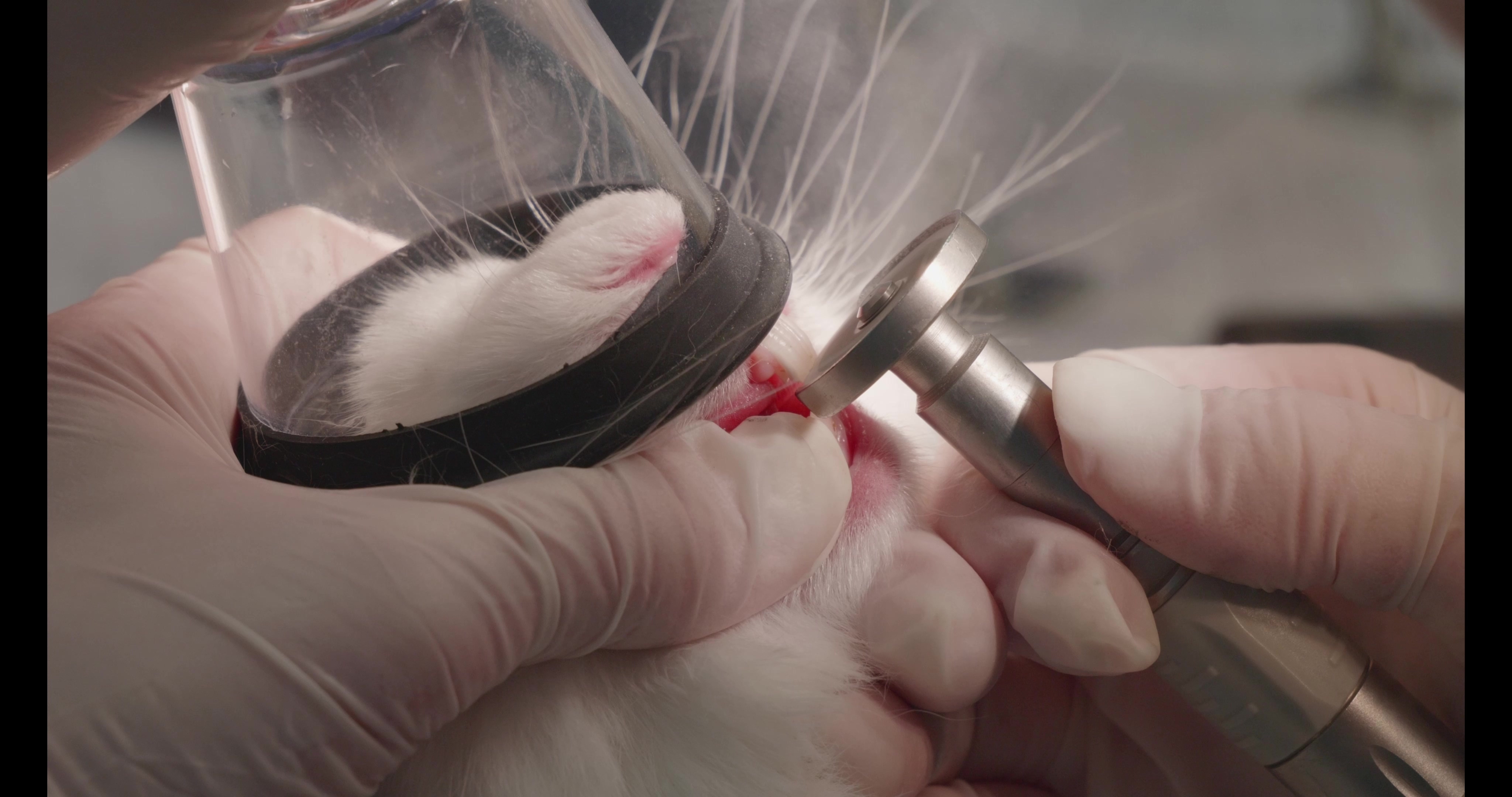How To Care for Rabbit Teeth
Narongrit Sritana/iStock / Getty Images Plus via Getty Images
Rabbits make fantastic family companions, but like any other pet, they thrive with proper care. This includes regular vet checkups, a nutritious diet, engaging activities, and a spacious habitat.
Rabbit teeth in particular are special and require unique attention to prevent potential problems. The good news is maintaining rabbit teeth can be straightforward with a little research, following good rabbit husbandry practices, and working closely with your veterinarian.
What Do Rabbit Teeth Look Like?
Rabbits have a fascinating dental setup! Here's a breakdown:
-
Six incisors are found in front—four on top and two on the bottom. These are essential for grabbing and chopping food.
-
Unlike many other mammals, rabbits lack canine teeth.
-
The "cheek teeth," consisting of premolars and molars, are located inside the mouth on both sides. These are responsible for grinding food.
In a healthy rabbit, the top and bottom incisors touch when the mouth is closed. However, the cheek teeth don't constantly meet.
When eating, the rabbit uses the incisors to grab and cut food. Then, the food gets transferred to the cheek teeth for grinding in a side-to-side motion. During this chewing action, the incisors will no longer touch.
The part of the tooth we can see above the gumline is called the crown. This is where any signs of disease might be visible.
The part below the gumline, called the root, can only be examined with the help of X-rays. Unfortunately, rabbits can have problems in both the crown and root of their teeth.

Click here to download this medical illustration.
How To Maintain Healthy Rabbit Teeth
Rabbits evolved to eat a diet rich in roughage, like grasses, succulents, and dry plants. This constant chewing wears their teeth down naturally, which is crucial because their teeth never stop growing!
Without this continuous wear, their teeth would become too long, making it impossible to eat. In fact, their teeth grow about 3 millimeters each week.
Thankfully, their ever-growing teeth are perfectly adapted to their diet. However, to ensure proper wear and prevent dental issues, rabbits need to chew almost constantly.
Here's what to give your bunny to help maintain your rabbit's healthy teeth:
-
Hay: Provide unlimited access to high-quality grass hays like Oxbow® Timothy or Orchard Hay Blends. Hay keeps their teeth grinding and their digestive system happy.
-
Veggie variety: Offer a daily portion of fresh, rabbit-safe vegetables like collard greens, dandelion greens, lettuces, bok choy, endive, and escarole.
-
Pellets: Limited amounts of high-quality rabbit pellets can be included in their diet.
-
Chew toys: Provide safe and vet-approved chew toys to keep your bunny mentally stimulated and prevent boredom. Make sure the toys are untreated, especially wood toys, to avoid any harmful chemicals.
How To Check Your Rabbit’s Teeth
Just like any other pet, your rabbit needs, at minimum, annual veterinary checkups. During these visits, the vet will thoroughly examine your bunny rabbit's teeth, assessing for any overgrowth or misalignment issues.
If you feel comfortable doing so, you can also try to gently examine your rabbit's front teeth at home. This can help you get familiar with their normal appearance and potentially spot any early signs of problems.
Sit on the floor and gently hold your rabbit in your lap. Wrap them in a towel, leaving their head exposed. This helps keep them calm and prevents them from jumping or hurting themselves.
Without this continuous wear, their teeth would become too long, making it impossible to eat. In fact, their teeth grow about 3 millimeters each week.
With your fingers or a tongue depressor, carefully lift your rabbit's lips to view the front teeth and gums. Remember, most pet owners can only see the incisors. The premolars and molars require a trained veterinary professional and specialized equipment.
Early detection is key to address any issues before they lead to larger health problems.
If your rabbit seems stressed or struggles during this process, don't force it. Always prioritize their well-being and consult your veterinarian.
What Are Overgrown Rabbit Teeth?
Overgrown rabbit teeth are one of the most common conditions affecting rabbits. There are a variety of factors that cause teeth to grow abnormally, including:
-
Genetics: Selective breeding over time can sometimes lead to misaligned jaws in rabbits, making proper tooth wear difficult. Lop-eared rabbits (i.e. Holland Lop, Mini Lop), with their shorter jaws, are particularly prone to dental issues.
-
Trauma: A fall, rough play, or any facial injury can cause broken or loose teeth. Seek immediate veterinary care to prevent further problems.
-
Diet: Limited access to hay, a crucial part of a rabbit's diet, is a major culprit of poor teeth alignment. Pellets alone are too soft and don't require proper chewing, leading to overgrown teeth. Remember, hay should always be available. Rabbits on pellet-only diets are most commonly affected, as the pellets break up easily and do not require much chewing or grinding. Rabbits should never be fed pellets only.
-
Other: Diseases affecting the bone health may cause loose teeth.
Pet parents may notice multiple signs of dental disease in their rabbits. However, because they are a prey species, rabbits tend to hide their illness. This is one of the reasons that frequent exams at home and checkups with the vet are important. Common signs of dental disease include:
-
Weight loss
-
Loss of appetite or decreased appetite
-
Difficulty keeping food in their mouth
-
Bulging eyes (from root issues like infection or overgrowth pushing on the eyes)
-
Increased tear production (incisor roots are close to the tear duct which can become blocked from inflammation or the tooth itself)
-
Nasal discharge from inflammation or infection leading into the sinuses
-
Grinding teeth
-
Swellings on the jaw
-
Increased saliva production
-
Diarrhea, if not able to eat a proper diet with nutrients
-
Eventual dehydration, which may look like lethargy and the inability to move
Overgrown incisor teeth may not meet in the center, may grow sideways, or may be uneven in length. They are often elongated. You may even sometimes see sharp edges or broken pieces.
Overgrown cheek teeth are usually only seen by a trained vet with special instruments, like speculums, that help keep the mouth gently open and provide light. Ideally, cheek teeth should have flat surfaces that meet properly for grinding food.
Overgrown cheek teeth may develop sharp points or abnormal shapes that hinder chewing. If proper grinding doesn’t occur, cheek teeth start having spikes or abnormal waves in the teeth that make grinding even harder.
How To Trim Rabbit Teeth
While the idea of trimming your rabbit's teeth yourself might seem tempting, it's actually quite risky. Pet parents should never attempt trimming rabbit teeth on their own.
Tools like clippers or nail trimmers apply pressure before cutting, and can actually fracture the teeth, leading to pain, infection, and more problems. These methods are now considered cruel due to the unnecessary suffering they cause.
Trimming safely requires anesthesia or sedation. Sedation allows the vet to take X-rays (radiographs) to assess root health and check for abnormalities around the tooth.
Vets use specialized equipment like high-speed dental tools for precise cutting with minimal pressure. Dremel® tools are sometimes used, but take longer and might require more pressure. The vet's priority is to avoid the pulp cavity, which could cause pain and infection.

In severe cases, removing the tooth entirely (extraction) might be necessary. Your vet will discuss this option if it's the best course of action for your rabbit.
For cheek teeth problems, anesthesia is essential. The vet will use a flat bur to grind down any spikes or abnormal shapes that hinder chewing.
With proper dental care and regular vet checkups, most rabbits can maintain healthy teeth and avoid the need for trimming altogether.
Remember, pet rabbits require specialized care for their teeth. Leaving the trimming to a qualified vet ensures your bunny receives the safest and most effective treatment for a happy, healthy smile.
References
Crossley, BVetMed, MRCVS, Fellow AVD, DEVDC, David. Lafeber Vet. Dental Disease in Rabbits and Rodents. 2010.
Brown DVM, Susan. Veterinary Partner. Rabbit Dental Disease. 2001.
